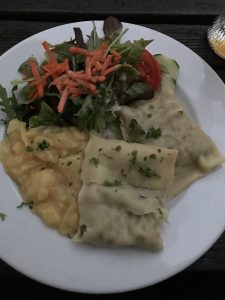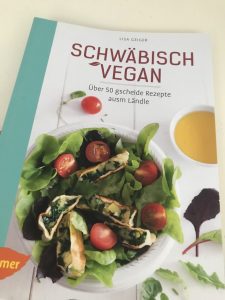Hochdeutsch und Schwäbisch
Als ich in Stuttgart ankam, ist es mir aufgefallen, dass es hier einen klaren regionalen Dialekt gibt: der ist nicht zu vermeiden und der heißt Schwäbisch! Ich habe vor meiner Anreise recherchiert, wie’s gesprochen wird, welche Worte unterschiedlich im Gegensatz zu Hochdeutsch sind, und die paar Youtube-Videos haben mir, ganz ehrlich gesagt, Angst gegeben. Ich hatte bisher nur Erfahrung mit Hochdeutsch und ein bißchen auch mit Sächsisch, mehr aber nicht. Am Anfang war’s d enn ganz klar eine Schwierigkeit, alles beim Bäcker, Supermarkt oder im Lehrerzimmer zu verstehen. Natürlich kommt es auf die Person an, mit der man redet, da Manche eh aus dem ‚Ländle‘ (Baden-Württemberg auf Schwäbisch) und Andere aus anderen Gebieten mit wenig starken Dialekten und Akzenten kommen. Diejenigen, die laut meiner Erfahrung am meisten und am stärksten auf Schwäbisch schwätzen, sind die, die aus dem breiteren Gebiet kommen – nicht so direkt von der Stadt Stuttgart. Das heißt aber natürlich nicht, dass Stuttgarter nicht auf Schwäbisch schwätzen! Die Stadt hat einfach mehr Leute aus ganz Deutschland und aller Welt, was heißt, nicht jeder spricht Schwäbisch!
enn ganz klar eine Schwierigkeit, alles beim Bäcker, Supermarkt oder im Lehrerzimmer zu verstehen. Natürlich kommt es auf die Person an, mit der man redet, da Manche eh aus dem ‚Ländle‘ (Baden-Württemberg auf Schwäbisch) und Andere aus anderen Gebieten mit wenig starken Dialekten und Akzenten kommen. Diejenigen, die laut meiner Erfahrung am meisten und am stärksten auf Schwäbisch schwätzen, sind die, die aus dem breiteren Gebiet kommen – nicht so direkt von der Stadt Stuttgart. Das heißt aber natürlich nicht, dass Stuttgarter nicht auf Schwäbisch schwätzen! Die Stadt hat einfach mehr Leute aus ganz Deutschland und aller Welt, was heißt, nicht jeder spricht Schwäbisch!
Ein großer Unterschied zwischen Schwäbisch und Hochdeutsch ist die Aussprache: Schwaben weisen ganz klar auf auf den –sh Sound hin, anstatt den –s Sound beim Hochdeutsch. Das heißt, dass man oft die Worte bisht und warsht anstatt bist und warst hört, was am Anfang auch ziemlich verwirrend sein kann! Eine andere Endung, die zu Worten hinzugefügt wird, ist der Sound –le, was die Endung -lein oder -chen auf Hochdeutsch sozusagen ‚ersetzt‘. Das gibt die Bedeutung klein und führt zu Worten wie ‚Schlössle‘, und ‚bissle‘. Schwäbisch ist aber nicht nur sprachlich anders, sondern auch vom Gefühl her: Schwäbisch zeichnet sich durch seine Geräusche, Worte und Betonungen aus und für mich ist es irgendwie freundlich zu hören. Höchstwahrscheinlich da ich meine eigenen Erfahrungen sowie meinen eigenen Freunden und Bekannten mit dem Dialekt habe! Es ist sehr besonders und muss bewahrt werden.
Standard German and Swabia
As I arrived in Stuttgart, I noticed that there was a clear regional dialect here: it’s unavoidable and is called Swabian! Before my arrival I did a bit  of research on how it’s spoken, which words are different to standard German and to be honest, the few YouTube videos I watched scared me a little. I’d only previously had experience with standard German, as well as a bit of Saxon German. For this reason, it was obviously quite a struggle trying to understand everything at the bakery, supermarket or in the staff room. Obviously, it depends on the person you’re talking to, because some come from the ‘Ländle’, Swabian for Baden-Württemberg, and others from other regions with a less strong dialect or accent. In my experience, the people wh come from the wider region tend to speak with the heaviest and thickest Swabian – not necessarily those who come from the inner-city areas of Stuttgart. That doesn’t mean that people from Stuttgart don’t speak Swabian – it just points towards the fact that the city has more people from the whole of Germany and the world, meaning that not everybody does or can speak Swabian!
of research on how it’s spoken, which words are different to standard German and to be honest, the few YouTube videos I watched scared me a little. I’d only previously had experience with standard German, as well as a bit of Saxon German. For this reason, it was obviously quite a struggle trying to understand everything at the bakery, supermarket or in the staff room. Obviously, it depends on the person you’re talking to, because some come from the ‘Ländle’, Swabian for Baden-Württemberg, and others from other regions with a less strong dialect or accent. In my experience, the people wh come from the wider region tend to speak with the heaviest and thickest Swabian – not necessarily those who come from the inner-city areas of Stuttgart. That doesn’t mean that people from Stuttgart don’t speak Swabian – it just points towards the fact that the city has more people from the whole of Germany and the world, meaning that not everybody does or can speak Swabian!
A big difference between Swabian and standard German is the pronunciation: Swabians emphasise the -sh sound instead of the -s sound as in standard German. That means, you’ll often hear the words bisht and warsht instead of bist und warst, which can be quite confusing initially! Another ending that is added to words is the sound -le, which replaces the ending -lein or -chen in standard German. This gives the meaning small and leads to words such as ‘Schlössle‘, und ‚bissle’. Swabian isn’t just linguistically different, but also in terms of feeling: it differentiates itself through its sounds, words and emphases, and I feel that it’s somehow welcoming to hear. Most likely because I have my own experiences as well as my own friends and acquaintances with the dialect. It’s extremely special and has to be preserved!
